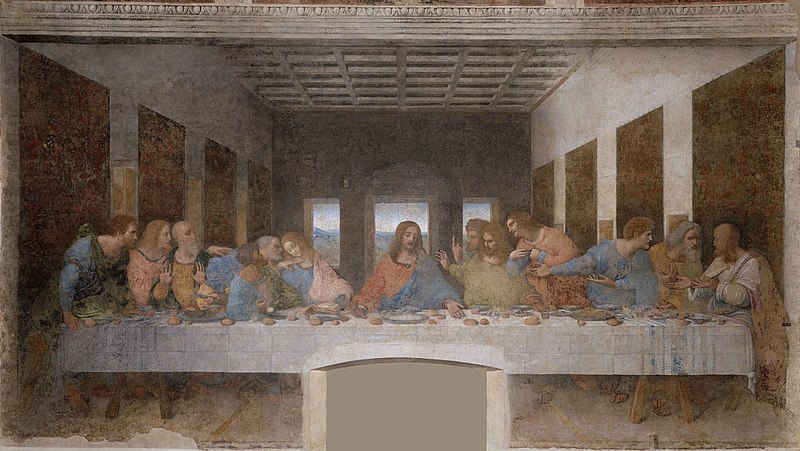
Since this image has become almost universally known in the west, it has been used as a source for later artistic images of the Last Supper and even for advertising campaigns and parodies. The iconic nature of Da Vinci's painting allows images from pop culture to replace Jesus and the disciples to evoke comedic and offensive reactions (see 50 Last Supper Parodies)
In 2001, controversial artist Renee Cox again employed the image of Da Vinci's "Last Supper" to make statements concerning women, race, religion, and politics. Her series of photographs, entitled "Yo Mama's Last Supper," were installed in the Brooklyn Museum of Art as part of a 2001 exhibit on contemporary black photographers. The images replace Jesus with a self-portrait of a nude Renee Cox surrounded by eleven black disciples and a white Judas. The images ignited a controversy when New York City Mayor Rudolph Guiliani called the installation "disgusting," "outrageous" and "anti-Catholic." He subsequently called for a "decency panel" to review all works of art shown in any museum that received public funds (Elisabeth Bumiller, NY Times, Friday, February 16, 2001, see the archive at nytimes.com). Cox responded, "Get over it," and subsequently went skiing for the weekend. Later in an interview with Salon.com, she elaborated on her feelings about the reaction: "The thing is, here in America, it still is a very puritanical state of mind going on and when people of Giuliani's ilk see something that is nude, somehow they react that it's obscene. I say you should refer back to Greek antiquities. The Met is full of naked Greek statues and no one is upset about that." Cox continued that in addition to the statement the images make about women, it was also a critique of the Catholic Church and how it has treated women, Africans, and all minorities, noting the lack of traditional images of people of color in classic Christian scenarios.

 Image Source: www.reneecox.net/series04/series04_1.htmlThe "Last Supper" by Leonardo da Vinci is one of the most iconic images of Jesus in the Western world. Da Vinci created the 15 x 29 ft. mural painting in the 15th century on behalf of his patron Duke Ludovico Sforza. Currently the painting hangs on a wall at Santa Maria delle Grazie in Milan, Italy. The painting depicts the meal that Jesus shared with his disciples on the night of his betrayal and arrest. The disciples are portrayed as frightened and dismayed, suggesting that Jesus had just announced his impending arrest and execution.
Image Source: www.reneecox.net/series04/series04_1.htmlThe "Last Supper" by Leonardo da Vinci is one of the most iconic images of Jesus in the Western world. Da Vinci created the 15 x 29 ft. mural painting in the 15th century on behalf of his patron Duke Ludovico Sforza. Currently the painting hangs on a wall at Santa Maria delle Grazie in Milan, Italy. The painting depicts the meal that Jesus shared with his disciples on the night of his betrayal and arrest. The disciples are portrayed as frightened and dismayed, suggesting that Jesus had just announced his impending arrest and execution.
Since this image has become almost universally known in the west, it has been used as a source for later artistic images of the Last Supper and even for advertising campaigns and parodies. The iconic nature of Da Vinci's painting allows images from pop culture to replace Jesus and the disciples to evoke comedic and offensive reactions (see 50 Last Supper Parodies)
In 2001, controversial artist Renee Cox again employed the image of Da Vinci's "Last Supper" to make statements concerning women, race, religion, and politics. Her series of photographs, entitled "Yo Mama's Last Supper," were installed in the Brooklyn Museum of Art as part of a 2001 exhibit on contemporary black photographers. The images replace Jesus with a self-portrait of a nude Renee Cox surrounded by eleven black disciples and a white Judas. The images ignited a controversy when New York City Mayor Rudolph Guiliani called the installation "disgusting," "outrageous" and "anti-Catholic." He subsequently called for a "decency panel" to review all works of art shown in any museum that received public funds (Elisabeth Bumiller, NY Times, Friday, February 16, 2001, see the archive at nytimes.com). Cox responded, "Get over it," and subsequently went skiing for the weekend. Later in an interview with Salon.com, she elaborated on her feelings about the reaction: "The thing is, here in America, it still is a very puritanical state of mind going on and when people of Giuliani's ilk see something that is nude, somehow they react that it's obscene. I say you should refer back to Greek antiquities. The Met is full of naked Greek statues and no one is upset about that." Cox continued that in addition to the statement the images make about women, it was also a critique of the Catholic Church and how it has treated women, Africans, and all minorities, noting the lack of traditional images of people of color in classic Christian scenarios.

 Image Source: www.reneecox.net/series04/series04_1.html
Image Source: www.reneecox.net/series04/series04_1.html
the last supper parody
ReplyDeletedenim shoes
borg quotes
air conditioned shoes
largest bathtub